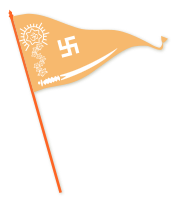Akhil Bharatiya Hindu Mahasabha | |
|---|---|
 | |
| Founder | Madan Mohan Malaviya |
| Founded | 1915 (as organization) 1933 (as political party)[1] |
| Split from | Indian National Congress[1] |
| Headquarters | New Delhi |
| Ideology | Hindutva[2][3] Hindu nationalism[2][4] Ultranationalism[5][6] Social conservatism[7][8] National conservatism[9] Economic nationalism[10] Right-wing populism[11] |
| Political position | Right-wing[12][13] to far-right[4][14] |
| Colours | Saffron |
| ECI Status | Registered Unrecognised[15] |
| Seats in Lok Sabha | 0 / 543
|
| Seats in Rajya Sabha | 0 / 245
|
| Seats in State Legislative Assembly | 0 / 4,036
|
| Seats in State Legislative Council | 0 / 426
|
| Number of states and union territories in government | 0 / 31
(Collectively 28 States & 3 UTs) |
| Election symbol | |
 [16] [16] | |
| Party flag | |
 | |
| Website | |
| abhm | |

Akhil Bharatiya Hindu Mahasabha (lit. 'All-India Hindu Grand Assembly') is a Hindu nationalist political party in India.[2][17][18]
Founded in 1915 by Madan Mohan Malviya, the Mahasabha functioned mainly as a pressure group advocating the interests of Orthodox Hindus before the British Raj from within the Indian National Congress.[2] In the 1930s, it emerged as a distinct party under the leadership of Vinayak Damodar Savarkar, who developed the concept of Hindutva (lit. 'Hinduness') and became a fierce opponent of the western, secular nationalism espoused by the Congress.
During the World War II, the Mahasabha supported the British war effort and briefly entered coalitions with the Muslim League in provincial and central legislative councils. They opposed the integration of the princely states into India.[19] After the assassination of Indian leader Mahatma Gandhi by a Hindu Mahasabha activist Nathuram Godse, the Mahasabha's fortunes diminished in post-Independence Indian politics, and it was soon eclipsed by the Bharatiya Jana Sangh.
- ^ a b Ali, Tariq (1985). An Indian Dynasty. G.P. Putnam. p. 196.
- ^ a b c d Jha 2018, pp. 1–4.
- ^ Bapu 2013, p. 61.
- ^ a b Six, Clemens (2017). Secularism, Decolonisation, and the Cold War in South and Southeast Asia. Routledge.
The Hindu Mahasabha, a far-right Hindu nationalist political party
- ^ Bingham, Woodbridge (1974). A History of Asia. Allyn and Bacon. p. 601.
- ^ Hauner, Milan (1981). India in Axis strategy. Klett-Cotta. p. 66.
- ^ Jaffrelot, Christophe (2010). Religion, Caste, and Politics in India. Primus Books. p. 63.
- ^ Cush, Denise (2012). Encyclopedia of Hinduism. Routledge. p. 316.
- ^ Misra, Amalendu (1999). "Savarkar and the Discourse on Islam in Pre-Independent India". Journal of Asian History. 33 (2): 175.
- ^ Chatterjee, Nirmal C. (1959). Hindu Mahasabha Tracts. Vedic Press. p. 12.
- ^ Tamadonfar, Mehran (2013). Religion and Regimes. Lexington Books. p. 125.
- ^ Delap, L (2013). Men, Masculinities and Religious Change in Twentieth-Century Britain. Springer. p. 152.
- ^ Kumaraswamy, P.R. (2010). India's Israel Policy. Columbia University Press. p. 159.
- ^ Luce, Henry Robinson (17 October 1949). "INDIA: Anchor for Asia". Time. Vol. 54. Time Incorporated. p. 33.
- ^ "Archived copy" (PDF). Archived from the original (PDF) on 30 May 2018. Retrieved 29 May 2018.
{{cite web}}: CS1 maint: archived copy as title (link) - ^ Vikram Doctor (18 November 2013). "Congress: History of election symbols: How they still help to connect with the masses". The Economic Times. Archived from the original on 18 October 2021. Retrieved 18 October 2021.
Other parties were happier with what they got – the Hindu Mahasabha had a suitably aggressive horse and rider..
- ^ McDermott, Rachel Fell; Gordon, Leonard A.; Embree, Ainslie T.; Pritchett, Frances W.; Dalton, Dennis (2014). Sources of Indian Traditions: Modern India, Pakistan, and Bangladesh. Columbia University Press. pp. 439–. ISBN 978-0-231-51092-9.
- ^ Klostermaier, Klaus K. (1989). A Survey of Hinduism: First Edition. SUNY Press. pp. 403–. ISBN 978-0-88706-807-2.
- ^ Bapu 2013, pp. 32–33.